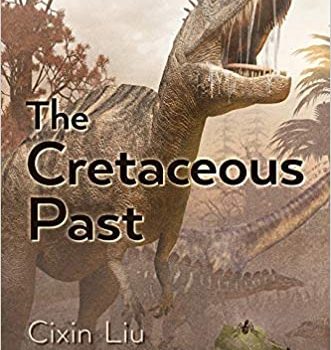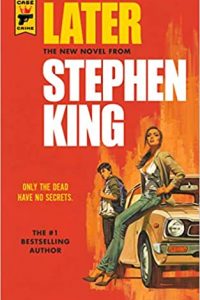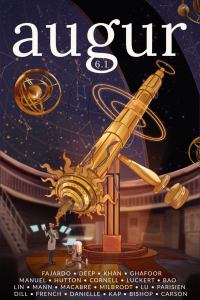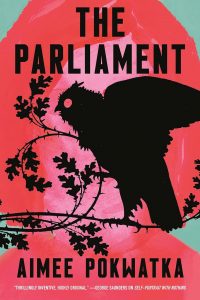Paul Di Filippo Reviews The Cretaceous Past by Cixin Liu
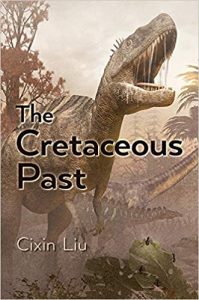 The Cretaceous Past, Cixin Liu (Subterranean 978-1645240150, $40.00, 192pp, hc) May 2021.
The Cretaceous Past, Cixin Liu (Subterranean 978-1645240150, $40.00, 192pp, hc) May 2021.
One of the amazing things about Cixin Liu’s writing, as I observed when I reviewed his short-story collection To Hold Up the Sky, is that “he is at once a radical and a conservative, an optimist and a pessimist, a member of the Old Guard and of the New Wave simultaneously.” His tales have a way of looking old-fashioned or even retro, only to explode or shape-shift into postmodernism rife with au courant relevance. His current novel (ISFDB shows the Chinese original appearing first in 2004) is a case in point, although perhaps this one does tip the balance more toward its initial old-school presentation and affect, which lingers throughout. More light-hearted (although still full of Liu’s patented grand-scale disasters), it’s an old-fashioned speculative look back into the deep past, as well as a wry parable about politics, hubris, power, competitiveness, and intolerance.
Starting off, the book reminded me of something that might have flowed from the Golden Age pen of, say, John Taine (The Greatest Adventure) or Stanley Waterloo (The Story of Ab). We first get a little lecture about the vastness of geological time and the probability of the recurring genesis of intelligence, and then we are back in the Cretaceous period, 145 to 66 million years ago, learning that dinosaurs were actually high-level sapients, capable of primitive tool construction in a kind of Paleolithic fashion. At the same time we are introduced to a forerunner species of ants who are also our mental equals, both individually and collectively as a hive. The two species are going along happily in their isolated ways when a serendipitous act of cooperation between individuals from both races leads to a new tradition of near-symbiosis. Before you can say “two heads are better than one,” the conjoined species are bootstrapping themselves to grander levels of civilization.
The ants perform fine-scale manipulations (including surgery, which at its height of sophistication comes to resemble the scenario from Fantastic Voyage) for the dinos, as well as instantiating their ideas into gadgets, while the dinos offer the ants both huge heapings of meat (as a relief from scavenging on their own) and also inspiration, supplying the role of dreamers and visionaries as opposed to the ants’ engineering talents.
Now the story moves on through centuries and millennia in jump-cut Stapledonian fashion, although when Liu chooses to slow down and individuate a few characters and tell their particular stories, he does so with characteristically deft personal touches that “humanize” the creatures. Affinities to Harry Turtledove’s counterfactual brawling sentient dinosaurs are evident. (This novel is one of those rare SF outings that feature no traces of homo sapiens whatsoever.) We witness the first Dino-Ant War (over religious matters), then the approach to the gradual zenith of their dual civilization, which attains levels similar to ours in 2021. Liu has a blast detailing the alien modalities of both dinos and ants. For instance, the automobiles of the saurians are like moving buildings, while their computer keyboards possess keys the size of a CRT screen. And the ants communicate by spelling out words with thousands of their own bodies.
But ultimately the ant-saurian entente hits the same wall of overpopulation, pollution, and resource depletion that we face today ourselves (emphasizing the parable elements of the novel), and rather than cooperate for a solution, the rivals bring everything down around their ears in a surprising manner, thus explaining why today there are no traces of this proto-civilization to be found.
If he were a lesser writer, Liu could have made this tale into a political allegory. But while the bad-ass, wild-eyed dinos share some qualities with capitalist Americans; and while the ants are indeed socialistic and hindered by a deficit of homegrown innovative abilities, there is ultimately no one-for-one mapping of our current situation onto their setup. Liu grants his imaginary races their own autonomy and uniqueness.
He also indulges in a bit of Lovecraftian atmosphere. Not the aspect of HPL that focused on eldritch and occult affairs, but that aspect which was concerned with cosmic scientific perspectives, especially the long vistas of time and space that are almost beyond human understanding. In his frequent descriptions of the Cyclopean architecture of the dinos, especially as seen from the POV of the ants, we get vibes similar to those in HPL’s “The Shadow Out of Time”.
In the end, this novel harks to no other author more than Stanislaw Lem. It’s like one of those lunatic forays into some bizarre yet organically authentic culture as detailed by cyber-savants Trurl and Klapaucius. From an Olympian perspective, jumping in and out of assorted time frames and viewpoint characters, Liu seeks to convey that shared glory and shame that attends to all attempts by any kind of sentience to mold the physical universe nearer to the heart’s desire—even if the hearts in question are as small as mustard seeds or as large as furnaces.
And please let us not forget that a full amount of credit for our enjoyment goes to translator Elizabeth Hanlon for some very readable and mellifluous prose.
 While you are here, please take a moment to support Locus with a one-time or recurring donation. We rely on reader donations to keep the magazine and site going, and would like to keep the site paywall free, but WE NEED YOUR FINANCIAL SUPPORT to continue quality coverage of the science fiction and fantasy field.
While you are here, please take a moment to support Locus with a one-time or recurring donation. We rely on reader donations to keep the magazine and site going, and would like to keep the site paywall free, but WE NEED YOUR FINANCIAL SUPPORT to continue quality coverage of the science fiction and fantasy field.
©Locus Magazine. Copyrighted material may not be republished without permission of LSFF.


